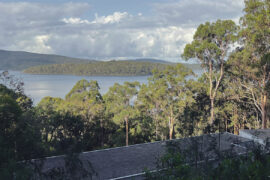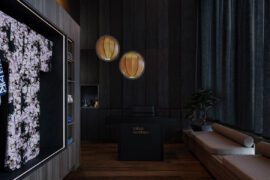What happens when rational, Modernist architecture puts down roots in a lush, tropical setting? Concrete Jungle, a new book by gestalten, explores locations across Asia and the world to find some of the most visionary residential adaptations of an international style to distinct local settings.

Art Villa by Formafatal and Refuel Works, Costa Rica, photograph by BoysPlayNice.
July 6th, 2023
The 20th century was in many ways defined architecturally by the long emergence, struggle for (or against) and broad victory of Modernism. With an emphasis on rationalism, applied using modern construction techniques and materials, it was a movement that claimed universal validity. Whether the requirements were a house on the outskirts of Paris or a whole government-administrative precinct in an Indian or Brazilian city, the same principles supposedly applied.
Concrete Jungle: Tropical Architecture and its Surprising Origins, recently published by gestalten, keys in to an important counter-current that has always accompanied debates around Modernism. With an emphasis on residential architecture across countries such as India, Vietnam, Brazil and Mexico, the book asks how the universal ideals of Modernism actually came to exist in the reality of tropical settings in these countries. How did the timelessness and even placelessness of those rational principles play out in reality?

One immediate answer is offered directly through the beautiful photography on show in the book – tropical greenery. The concrete that defines many of the houses is set apart in the way that so many of these buildings are integrated with the flora of their surroundings. At Padang Linjong Residence by Daniel Mitchell and Patisandhika Sidarta, located in Bali, for example, a large selection of plants softens the exposed concrete while a tree quite literally grows out of the living room floor.
The topic brings to mind wider debates in architectural theory concerning the tension between universalism and local context, most famously in Kenneth Frampton’s notion of Critical Regionalism. One of the subtexts of reading Modernism in tropical settings is a reclamation of unique local identities that often experienced Western claims to universalism as, in reality, more like an erasure of cultural specificities.
Related: Reviewing Richard Francis-Jones’ ‘Truth and Lies in Architecture’

The book engages with this level of thinking by including essays on Modernism as a nation-building exercise and its more contemporary manifestations. It includes examples from the work of globally significant architects such as Oscar Niemeyer, Luis Barragán, Lina Bo Bardi and Paulo Mendes de Rocha.

The topics and case studies are also highly relevant to Australia, with its far north tropical regions and distinct indigenous flora. Fortunata House by Luciano Lerner Basso, located in Brazil, for example, could act as a direct inspiration for house design in the tropical Australian Bush with its elevation off the ground and emphasis on preserving native vegetation.
Concrete Jungle: Tropical Architecture and its Surprising Origins is a journey across many more examples like this. Published in 2023, it is available through gestalten.
gestalten
gestalten.com
Photography
Various

INDESIGN is on instagram
Follow @indesignlive
A searchable and comprehensive guide for specifying leading products and their suppliers
Keep up to date with the latest and greatest from our industry BFF's!

Welcomed to the Australian design scene in 2024, Kokuyo is set to redefine collaboration, bringing its unique blend of colour and function to individuals and corporations, designed to be used Any Way!

For those who appreciate form as much as function, Gaggenau’s latest induction innovation delivers sculpted precision and effortless flexibility, disappearing seamlessly into the surface when not in use.

With projects shortlisted for Habitus House of the Year 2025, Anthony Gill and Jason Gibney join the podcast to discuss the state of housing in Australia today.

Making a splash on the hair spa scene, the latest project from X + O makes a little slice of Japan right at home in suburban Melbourne.
The internet never sleeps! Here's the stuff you might have missed

Tom Mark Henry refines a layered design legacy into a softly sculpted retreat in Redfern, where light, tactility and crafted detail define a new expression of restrained luxury.

Architects Declare and Suppliers Declare are uniting with the aim of making transparent, responsible specification the new industry standard.